Market
DeFi in Crisis: Restaking Protocols Are Devouring Liquidity
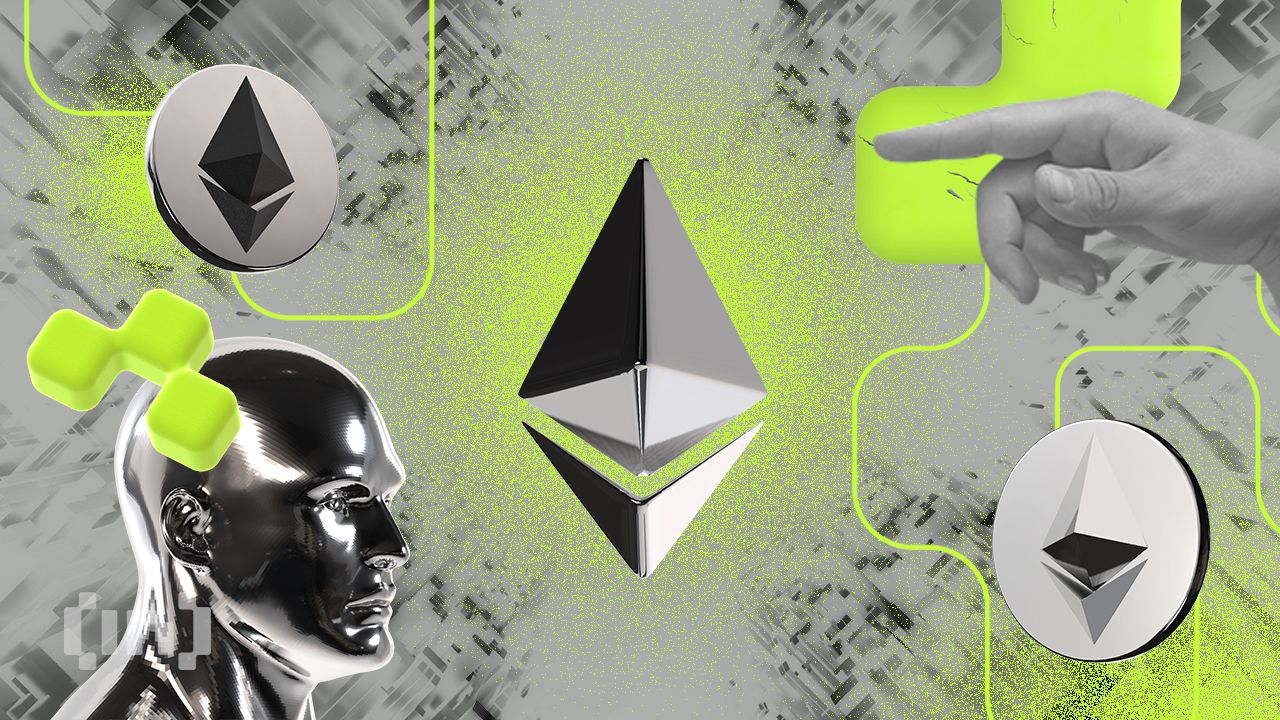
The DeFi space is expanding, with liquid staking and restaking protocols gaining more and more attention. These developments allow users to stake and reuse assets multiple times, offering the potential for higher yields. However, as these systems become more complex, they also introduce potential systemic vulnerabilities.
Projects like EigenLayer are pushing the limits of yield maximization, but are these returns sustainable? The question remains whether these innovations are setting DeFi up for lasting success or creating the next wave of risks.
The Growing Influence
Restaking protocols, led by platforms like EigenLayer, have become a major force in the decentralized finance (DeFi) sector. Restaking refers to the process where users take assets staked on one protocol, such as Ethereum’s liquid staking tokens (LSTs), and stake them again on another platform to earn additional yields.
This process has unlocked significant earning potential, driving restaking’s rise. In 2024, liquid restaking tokens (LRTs) saw an enormous 4,900% growth in Total Value Locked (TVL), surpassing $15 billion from a mere $280 million in early 2024.
“The push for higher yields is a key to keeping staking attractive, especially as the total amount of ETH staked on the Beacon Chain grows and the average APY (annual percentage yield) declines. This is one of the main reasons DeFi and restaking protocols have been so well-received,” Alon Muroch, CEO and Founder at SSV.Labs, told BeInCrypto in an exclusive interview.
Read more: Ethereum Restaking: What Is it and How Does it Work?
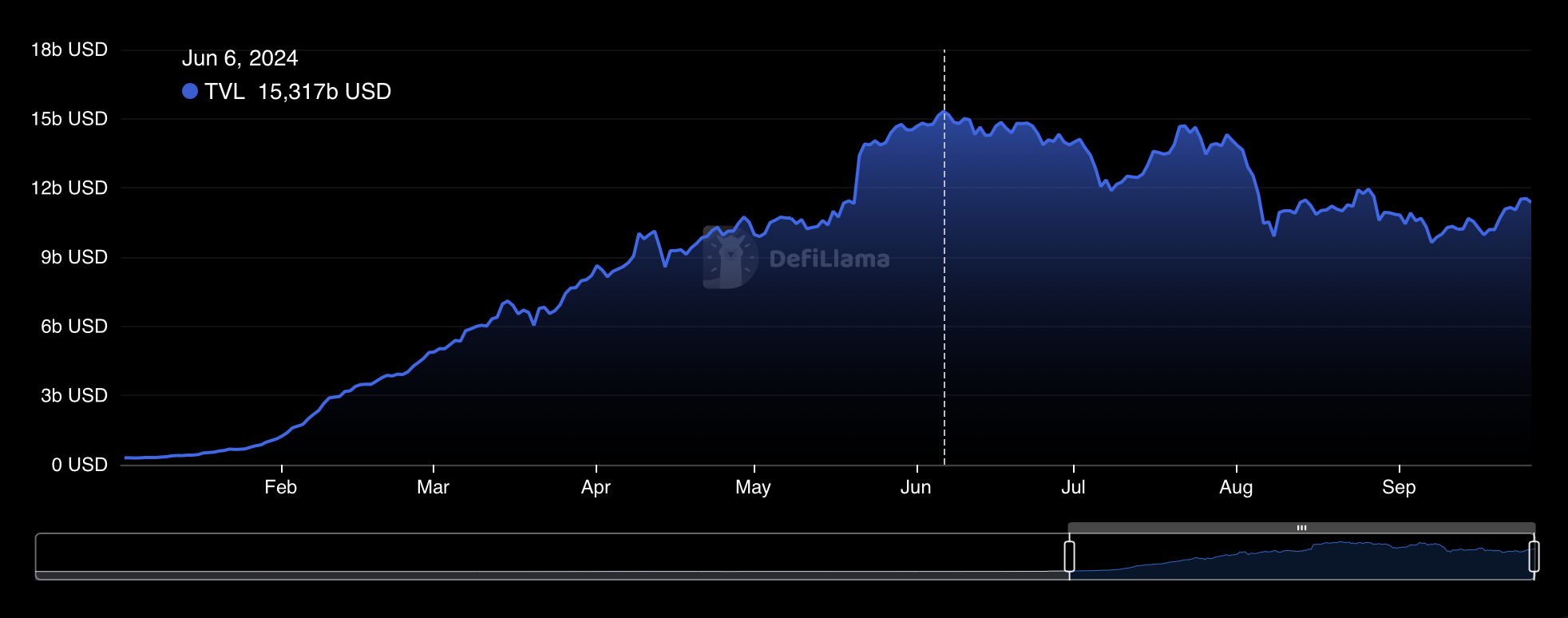
Restaking protocols offer users opportunities to maximize returns on their staked assets without having to sacrifice liquidity. However, as restaking scales, concerns about liquidity and security risks are emerging.
“Each additional layer in restaking increases both risk and reward, making it a choice that users must make based on their risk tolerance. While it introduces more potential points of failure, it also opens up opportunities for significantly greater returns. Ultimately, the user has the freedom to decide the level of exposure they are comfortable with,” Muroch added.
Balancing the Promise and Peril of Restaking
Although the ability to re-use staked assets has been celebrated as an innovation, it simultaneously introduces new layers of exposure. In essence, restaking involves leveraging staked assets across different protocols, which may sound appealing for yield optimization, but it creates systemic vulnerabilities.
Muroch identified several main problems associated with restaking:
- Smart Contract Vulnerabilities. The complexity of restaking mechanisms increases the potential for bugs and exploits in the smart contracts governing these protocols. Users may lose funds if a contract is compromised.
- Complexity and Lack of Understanding. As restaking strategies become more complex, there is a risk that users may not fully understand the risks they are taking on. Some Actively Validated Services (AVSs) have higher risk than others due to more/complex slashing criteria for different AVSs.
- Slashing Risks. If a validator is found guilty of malicious behavior, a portion of their restaked ETH can be slashed. This risk is compounded because node operators are subject to slashing conditions for both the Ethereum base layer and any additional AVSs.
Moreover, the financial architecture behind restaking has left DeFi exposed to potential liquidity drains. For example, EigenLayer’s current restaking system allows users to restake liquid staking tokens (LSTs) multiple times, amplifying liquidity challenges. These risks were evident in the Ankr exploit, where a hacker minted 6 quadrillion fake aBNBc tokens, crashing the price of liquid staking derivatives across various protocols.
The unclear regulatory frameworks add to the complexity of restaking. Muroch cautions that regulators will likely take a cautious approach to restaking, seeing it as distinct from traditional staking because of its added layers of risk and complexity. They may impose stricter regulations to protect investors and ensure the stability of the financial ecosystem as these protocols gain traction.
The Threat of Over-Restaking
EigenLayer, one of the biggest restaking protocols, has garnered over $19 billion in TVL by mid-2024. While this impressive expansion demonstrates the market’s appetite for higher yields, it raises questions about the sustainability of these protocols.
The dominance of EigenLayer also poses a unique threat to Ethereum’s overall security. Since these restaking platforms are handling large quantities of staked ETH, any major failure could directly impact Ethereum’s security model.
Experts, including Ethereum co-founder Vitalik Buterin, have voiced concerns that if a restaking protocol failed, it could lead to calls for a hard fork of Ethereum to “undo” the damage, an outcome that threatens the network’s decentralized consensus.
Read more: How to Participate in an EigenLayer Airdrop: A Step-by-Step Guide

Muroch, however, downplayed the severity of the situation, describing it as “theoretically bad, but practically quite unlikely.”
“If a significant amount of Ether is locked in EigenLayer and a large operator suffers a major slashing event, it could lead to a cascade of slashing damage. In a worst-case scenario, this could compromise the extended security of the Ethereum network. However, it would take the slashed operator not fixing the problem for a long period of time for Ethereum’s security to be threatened,” he explained.
He also highlighted an important upside, noting that restaking raises the cost of corruption for potential attackers. This shift strengthens security by focusing not just on individual protocols but on the total sum of all staked assets.
Hidden Dangers of Yield Optimization
The pursuit of higher yields has led stakers to adopt increasingly complex strategies, which carries both financial and technical risks. Financially, restaking protocols encourage users to stake their assets across multiple platforms, tying up more capital in interconnected systems. This raises systemic financial risks, as vulnerabilities in one protocol could trigger broader consequences across the ecosystem.
Muroch cautions that restaking is still a relatively new concept, making it difficult to predict its long-term effects. The potential for unforeseen issues, especially in volatile markets, adds uncertainty to the future of these strategies.
“Staking rewards have only recently been introduced, meaning it will take some time to fully understand their long-term effects. As always, there are ‘unknown unknowns’ that could arise. In the future, if the value of restaked assets were to drop sharply, the heavy reliance on rehypothecation and complex financial derivatives could trigger a liquidity crisis,” he said.
This would likely cause users to liquidate their positions en masse, worsening market volatility. In such a case, confidence in the underlying protocols might erode further, potentially causing widespread destabilization in the DeFi space.
“At this point it’s really speculative. Looking back to the past in DeFi, trying to milk yields as hard as possible tends to end badly,” Muroch warned.
Ultimately, the success of restaking protocols hinges on their ability to balance maximizing yields with managing the inherent financial and technical risks they introduce. As these systems mature, the sector is beginning to diversify. New competitors are launching their own restaking solutions, which could help decentralize risk currently concentrated in platforms like EigenLayer.
This shift may reduce the systemic vulnerabilities tied to one dominant protocol, leading to a more stable and resilient DeFi ecosystem over time.
“As excitement wanes, the sustainability of these protocols will be tested, and their true value will need to be assessed in a more stable market environment. This transition could reveal whether the innovations are robust or merely speculative trends,” Muroch concluded.
Disclaimer
Following the Trust Project guidelines, this feature article presents opinions and perspectives from industry experts or individuals. BeInCrypto is dedicated to transparent reporting, but the views expressed in this article do not necessarily reflect those of BeInCrypto or its staff. Readers should verify information independently and consult with a professional before making decisions based on this content. Please note that our Terms and Conditions, Privacy Policy, and Disclaimers have been updated.
Market
EDGE Goes Live, RSR Added to Roadmap

Coinbase, one of the leading cryptocurrency exchanges, has announced the addition of Reserve Rights (RSR) to its listing roadmap, signaling a strategic move to broaden its offerings.
This coincides with the exchange’s decision to list Definitive (EDGE), which has already sparked significant market activity.
Coinbase Adds RSR To Roadmap
Reserve Rights is an ERC-20 token native to the Reserve Protocol. The platform offers a permissionless decentralized framework for stablecoin development. It enables users to create yield-bearing, asset-backed, and overcollateralized stablecoins on the Ethereum (ETH) blockchain.
The addition of RSR to Coinbase’s listing roadmap has caught considerable attention, partly due to its association with Paul Atkins, President Donald Trump’s nominee for SEC Chair.
Atkins previously served as a crypto advisor for the Reserve Protocol. He is widely regarded as a crypto-friendly figure—standing in sharp contrast to his predecessor, Gary Gensler, who oversaw a stringent crackdown on the industry during his tenure.
Notably, the exchange’s move was celebrated by the platform.
“Great to see more opportunities for people to participate in the Reserve ecosystem,” Reserve Protocol posted on X (formerly Twitter).
Despite the development, RSR’s price has shown only modest movement.

According to the latest data, it was trading at $0.006. This reflected a 1.2% increase over the past 24 hours.
However, the token has gained strong community support. CoinMarketCap data showed a 91.6% bullish sentiment among users. This indicated increased user confidence in its potential.

EDGE Sees Triple-Digit Rally Post Coinbase Listing
While RSR’s price showed only small gains, the EDGE token’s reaction has been much more dramatic. Coinbase revealed via X that it would list the Definitive platform’s utility token, EDGE.
“Trading will begin later today if liquidity conditions are met. Once sufficient supply of this asset is established trading on our EDGE-USD trading pair will launch in phases. Support for EDGE may be restricted in some supported jurisdictions,” the announcement read.
Following this, EDGE saw its price surge by an impressive 120.6% to $0.091. Previously, a similar reaction was observed in Doginme (DOGINME) and Keyboard Cat (KEYCAT) after they secured a listing on the exchange.

EDGE’s listing, however, comes with an “Experimental” label. This is a designation Coinbase uses to indicate assets that may carry higher risk or volatility.
“The Experimental asset label will not impact your ability to send, receive, buy, sell and/or hold assets on Coinbase. However, we do ask you to read and confirm you understand the risks involved, such as price swings and canceled orders, before trading an experimental asset for the first time,” the blog reads.
As Coinbase continues diversifying its portfolio, the addition of RSR and EDGE highlights the growing acceptance of diverse blockchain projects. These listings may provide new opportunities for investors. However, the associated risks should be carefully considered.
Disclaimer
In adherence to the Trust Project guidelines, BeInCrypto is committed to unbiased, transparent reporting. This news article aims to provide accurate, timely information. However, readers are advised to verify facts independently and consult with a professional before making any decisions based on this content. Please note that our Terms and Conditions, Privacy Policy, and Disclaimers have been updated.
Market
10 Altcoins at Risk of Binance Delisting
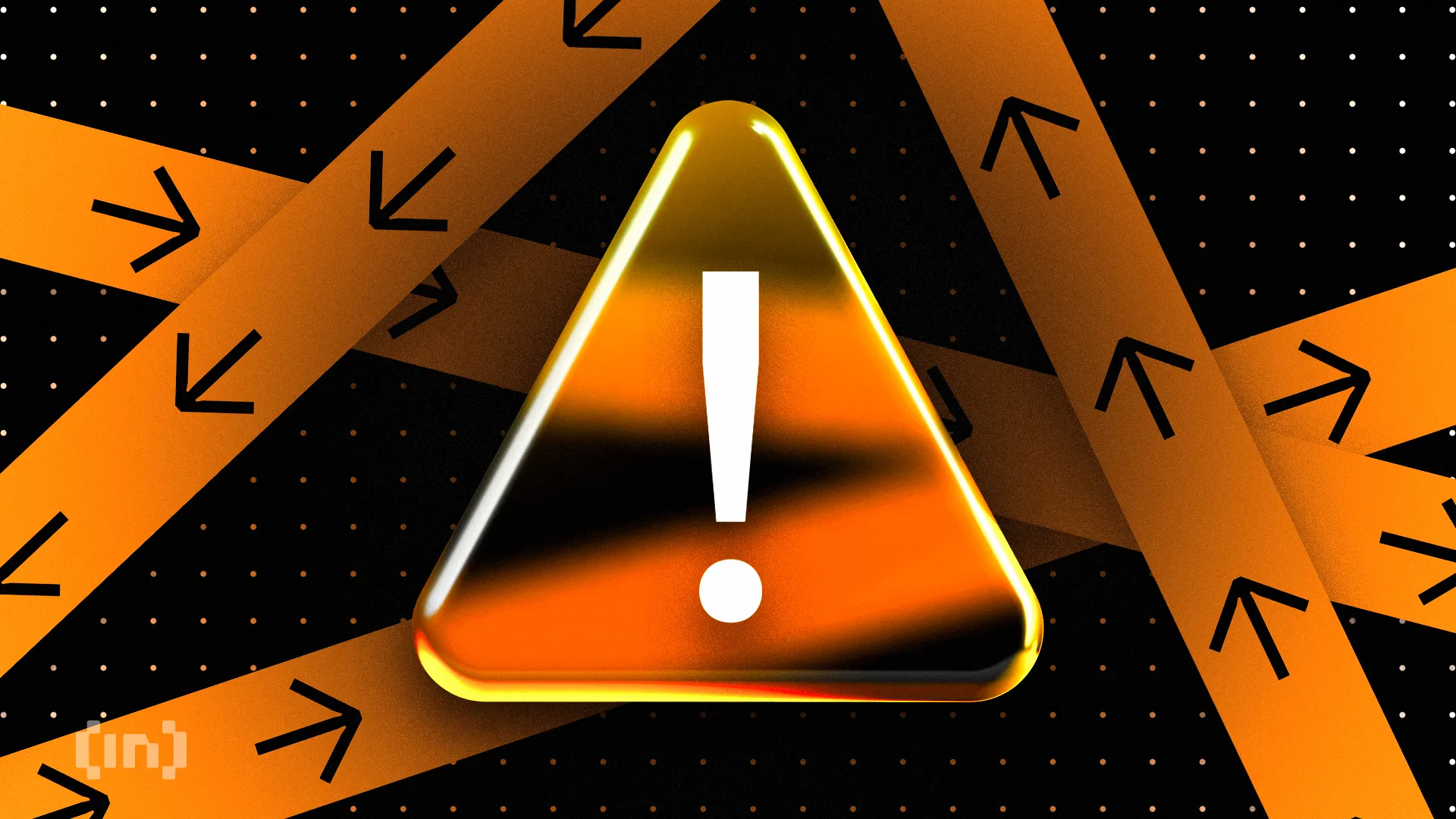
On April 3, Binance announced that it would add a new set of tokens to its monitoring list. These tokens are under closer scrutiny and may face delisting following the upcoming review period.
This move follows the exchange’s aims to increase transparency while offering more clarity regarding the risk levels associated with different cryptocurrencies.
10 Altcoins in Danger of Binance Delisting
As part of this update, the following tokens will be added to the Monitoring Tag list: Ardor (ARDR), Biswap (BSW), Flamingo (FLM), LTO Network (LTO), NKN (NKN), PlayDapp (PDA), Perpetual Protocol (PERP), Viberate (VIB), Voxies (VOXEL) and Wing Finance (WING).
Tokens added to the Monitoring Tag exhibit notably higher volatility and risk compared to other listed tokens. Binance will closely monitor these tokens, with regular reviews to assess their compliance with the platform’s listing criteria.
“Tokens with the Monitoring Tag are at risk of no longer meeting our listing criteria and being delisted from the platform,” Binance said.
Following the announcement, the prices of the mentioned altcoins plummeted by double-digits.
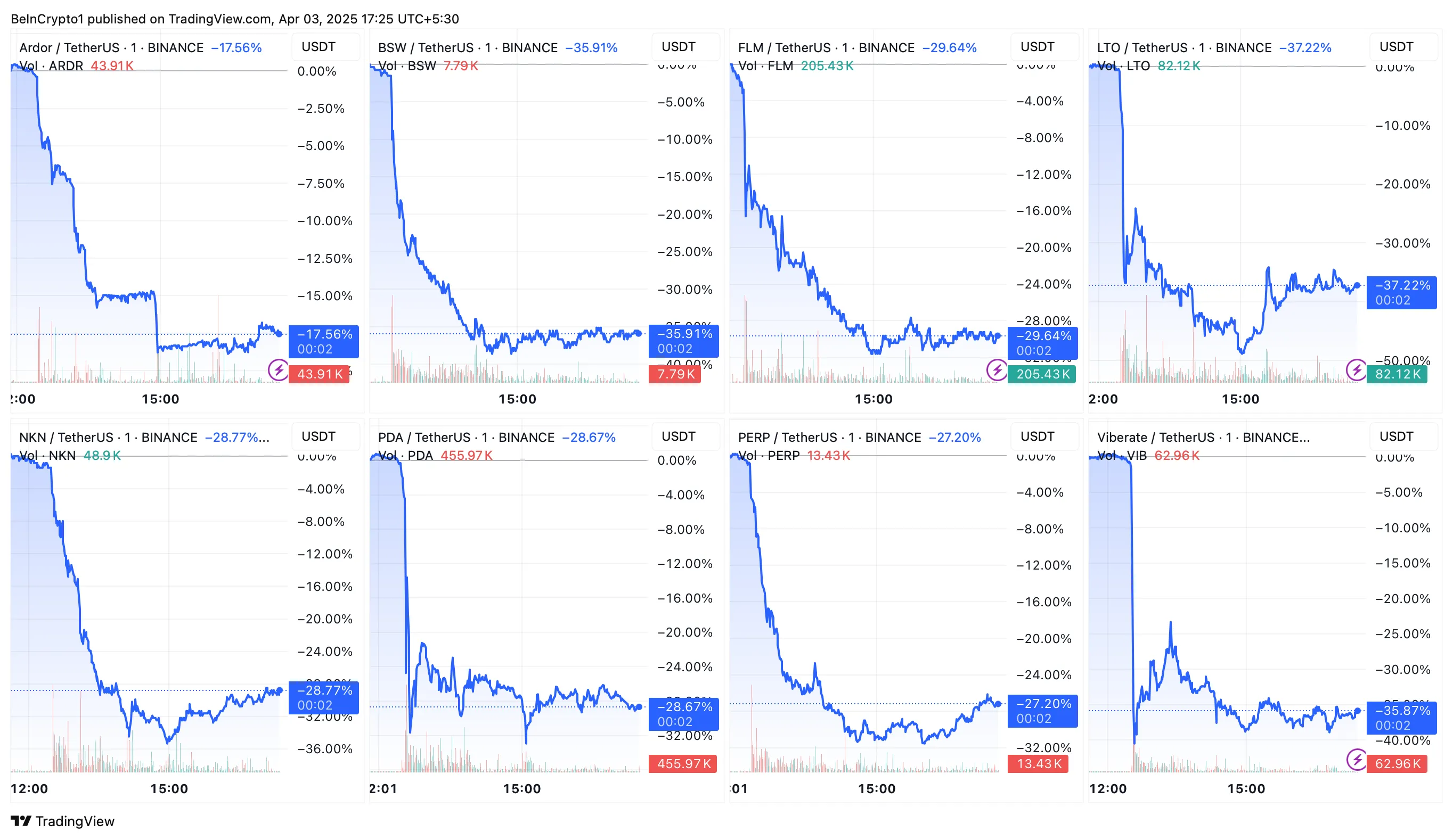
In addition to the new Monitoring Tag additions, Binance will also remove the Seed Tag from Jupiter (JUP), Starknet (STRK), and Toncoin (TON).
Tokens marked with the Seed Tag are those that are still in their early stages of development and have not yet met Binance’s full listing criteria. The removal of the Seed Tag indicates a change in the status of these projects. This suggests that they no longer fit the initial criteria for such a label.
Tokens with the Monitoring Tag or Seed Tag come with inherent risks. Binance ensures that users are well-informed before trading them. To access trading for these tokens, users must pass a risk awareness quiz every 90 days.
The quiz makes sure that users understand the potential risks associated with trading higher-risk tokens. Binance will also display a risk warning banner for these tokens on its Spot and Margin platforms.
Binance will continue to conduct periodic reviews of tokens with the Monitoring Tag and Seed Tag. During these reviews, several factors are taken into account. This includes the project team’s commitment, development activity, token liquidity, and community engagement.
The latest development follows a similar announcement from Binance in March. The exchange routinely delists tokens that fail to keep up with its criteria.
Disclaimer
In adherence to the Trust Project guidelines, BeInCrypto is committed to unbiased, transparent reporting. This news article aims to provide accurate, timely information. However, readers are advised to verify facts independently and consult with a professional before making any decisions based on this content. Please note that our Terms and Conditions, Privacy Policy, and Disclaimers have been updated.
Market
HBAR Foundation Eyes TikTok, Price Rally To $0.20 Possible
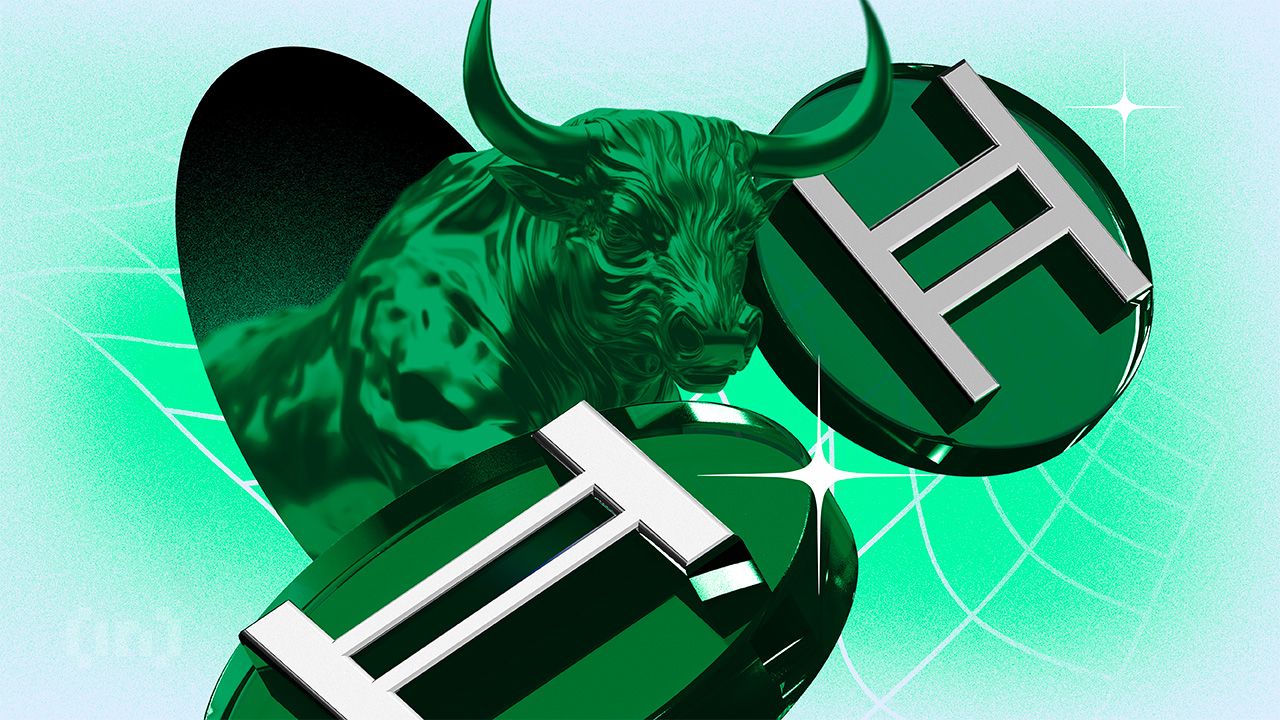
Hedera (HBAR) has faced a downtrend recently, with the crypto asset’s price failing to maintain support at $0.200. This failure to establish a solid base has led to a pullback.
However, key developments within the Hedera ecosystem and shifting investor sentiment could spark a potential price rally in the coming days.
HBAR Foundation Eyes TikTok
After nearly a month of bearish sentiment, investors are beginning to shift their stance towards bullishness. The Hedera Foundation’s recent move to team up with Zoopto for a late-stage bid to acquire TikTok has played a pivotal role in this shift. If the acquisition is approved, the partnership could expose HBAR to a massive audience due to TikTok’s extensive user base, potentially driving up demand and mainstream adoption.
The prospect of this collaboration has reignited interest among investors, sparking optimism about Hedera’s future growth potential. With TikTok’s wide-reaching influence, the strategic partnership could offer Hedera an edge in the competitive crypto market, encouraging further accumulation of HBAR tokens.
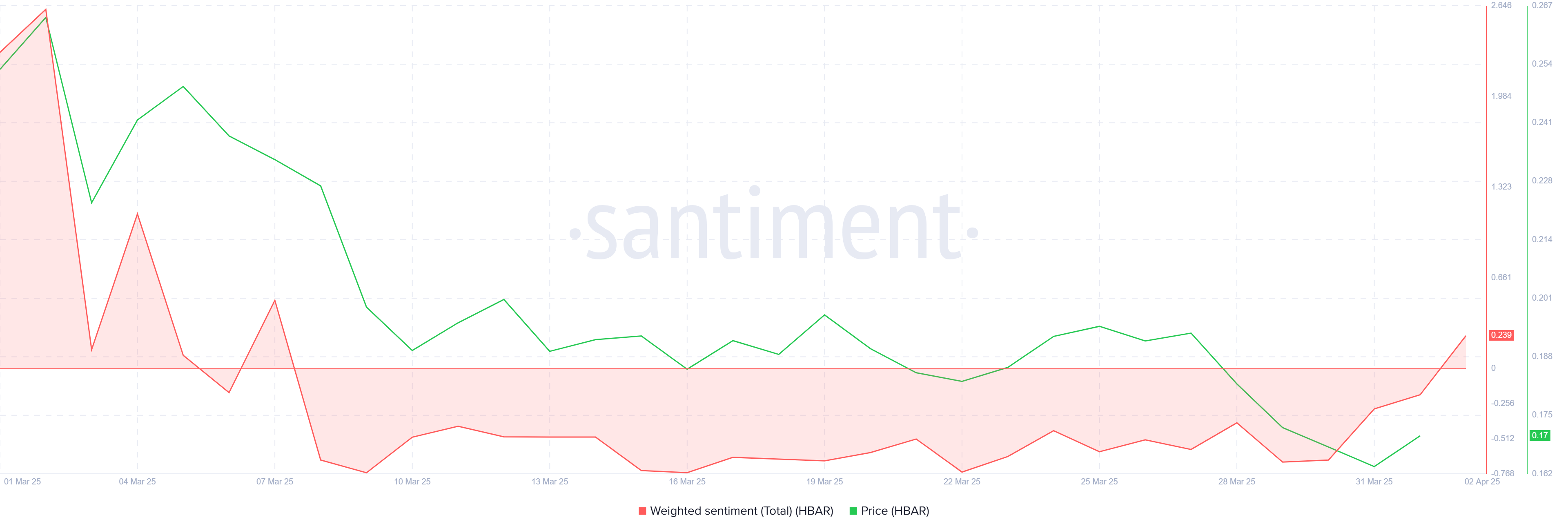
On the technical front, the Chaikin Money Flow (CMF) indicator is showing signs of recovery. The CMF has started to tick upwards, signaling a potential increase in inflows. While it hasn’t yet crossed above the zero line, the growing positive momentum indicates that more capital could be entering the market. Continued inflows could provide the necessary push for HBAR to break through key resistance levels.
The increase in capital flow suggests a strengthening of investor confidence. However, for a sustained rally, more substantial buying pressure will be required to move HBAR above its current price point. If this trend continues, HBAR may see a rise in both investor interest and market value in the near future.
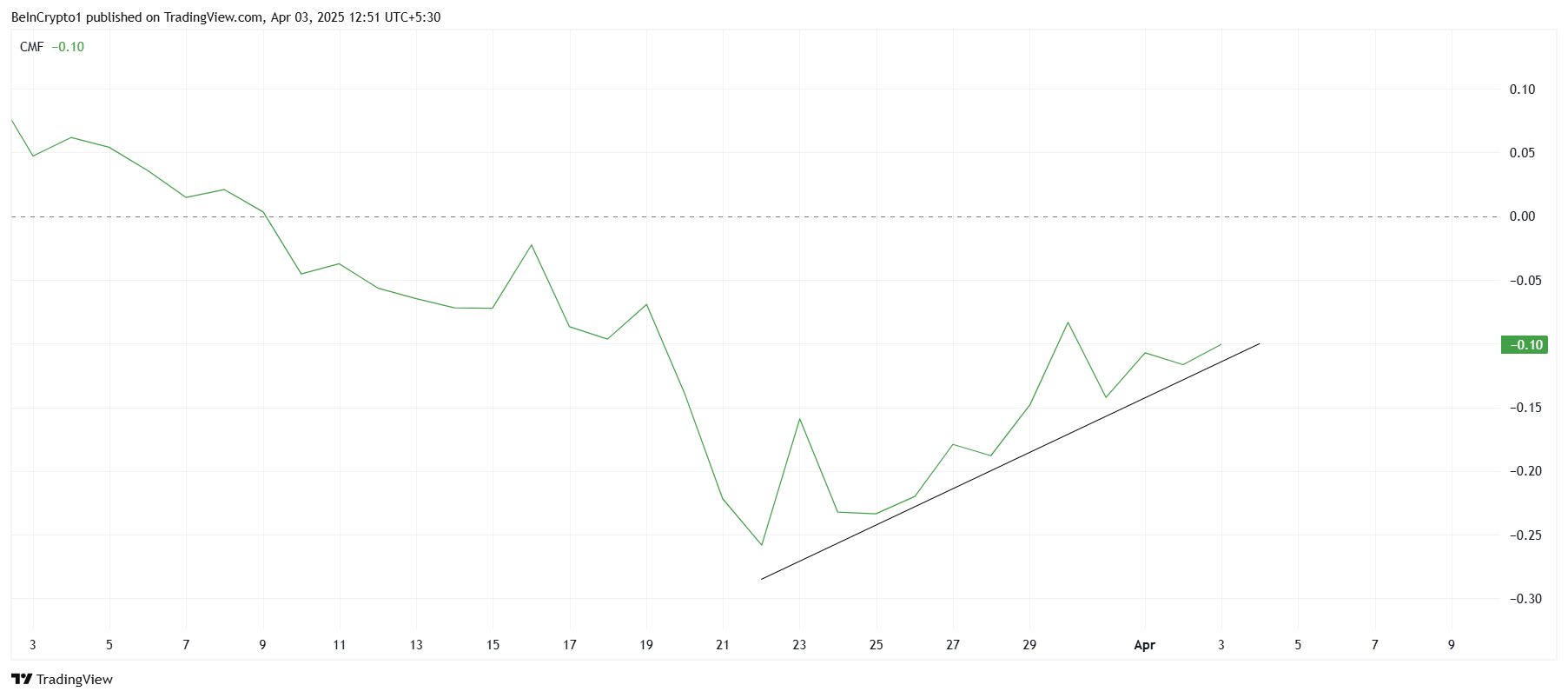
HBAR Price Finds Support
Currently, HBAR is priced at $0.161, just under the key resistance level of $0.165. The next significant resistance lies at $0.197, which has acted as a barrier to HBAR’s price recovery. With a 22% gap between the current price and this resistance, overcoming this hurdle could pave the way for a move toward $0.200.
Given the positive developments surrounding Hedera, it is plausible that HBAR could move toward these resistance levels. If the token can breach $0.165 and then $0.177, the path to $0.197 becomes much clearer. This would mark a critical point for HBAR as it seeks to regain lost ground.
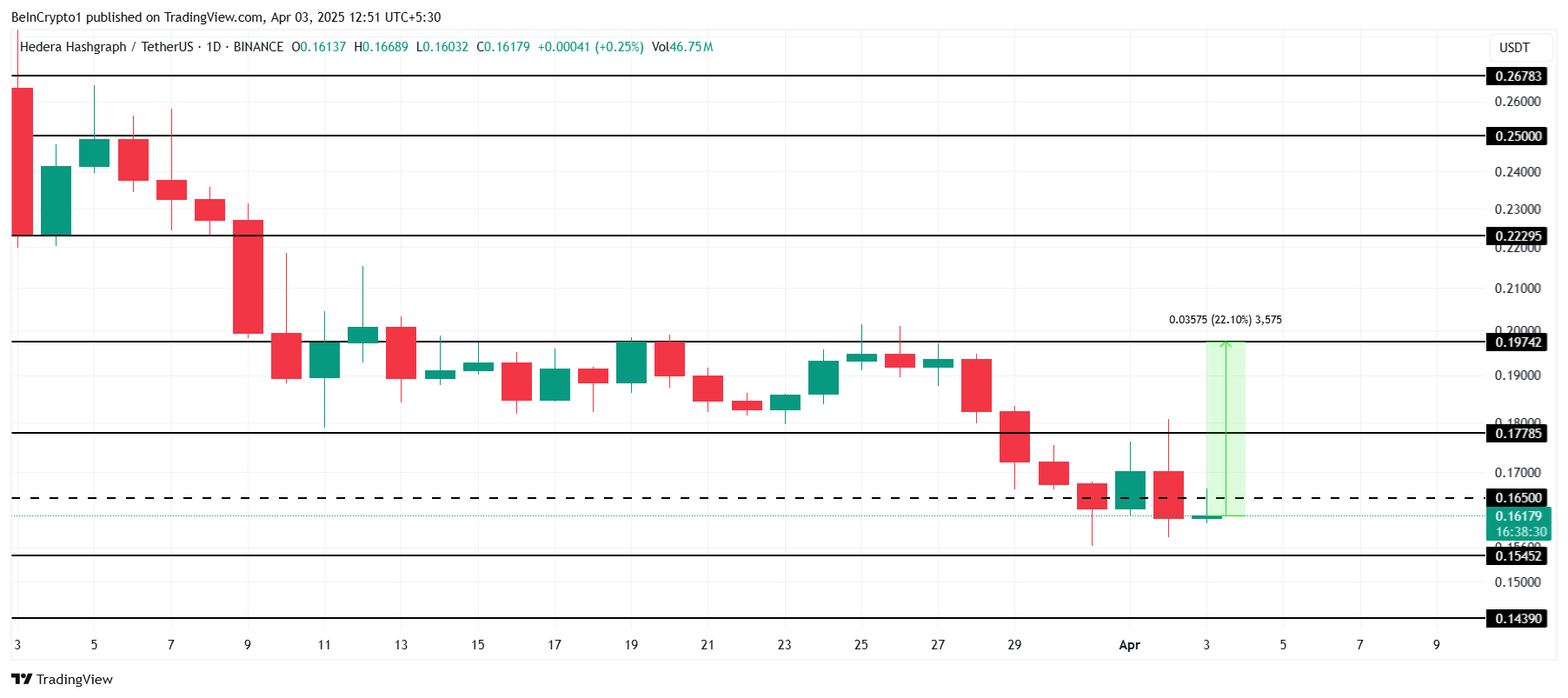
However, if investors decide to take profits and sell before further upward movement, HBAR could fail to breach the $0.177 resistance. Such a scenario could push the price back down towards $0.154 or $0.143, invalidating the bullish outlook and prolonging the consolidation phase.
Disclaimer
In line with the Trust Project guidelines, this price analysis article is for informational purposes only and should not be considered financial or investment advice. BeInCrypto is committed to accurate, unbiased reporting, but market conditions are subject to change without notice. Always conduct your own research and consult with a professional before making any financial decisions. Please note that our Terms and Conditions, Privacy Policy, and Disclaimers have been updated.
-

 Regulation23 hours ago
Regulation23 hours agoKraken Obtains Restricted Dealer Registration in Canada
-

 Altcoin20 hours ago
Altcoin20 hours agoHere’s Why This Analyst Believes XRP Price Could Surge 44x
-

 Ethereum17 hours ago
Ethereum17 hours agoWhy A Massive Drop To $1,400 Could Rock The Underperformer
-

 Altcoin15 hours ago
Altcoin15 hours agoFirst Digital Trust Denies Justin Sun’s Allegations, Claims Full Solvency
-

 Altcoin19 hours ago
Altcoin19 hours agoHow Will Elon Musk Leaving DOGE Impact Dogecoin Price?
-
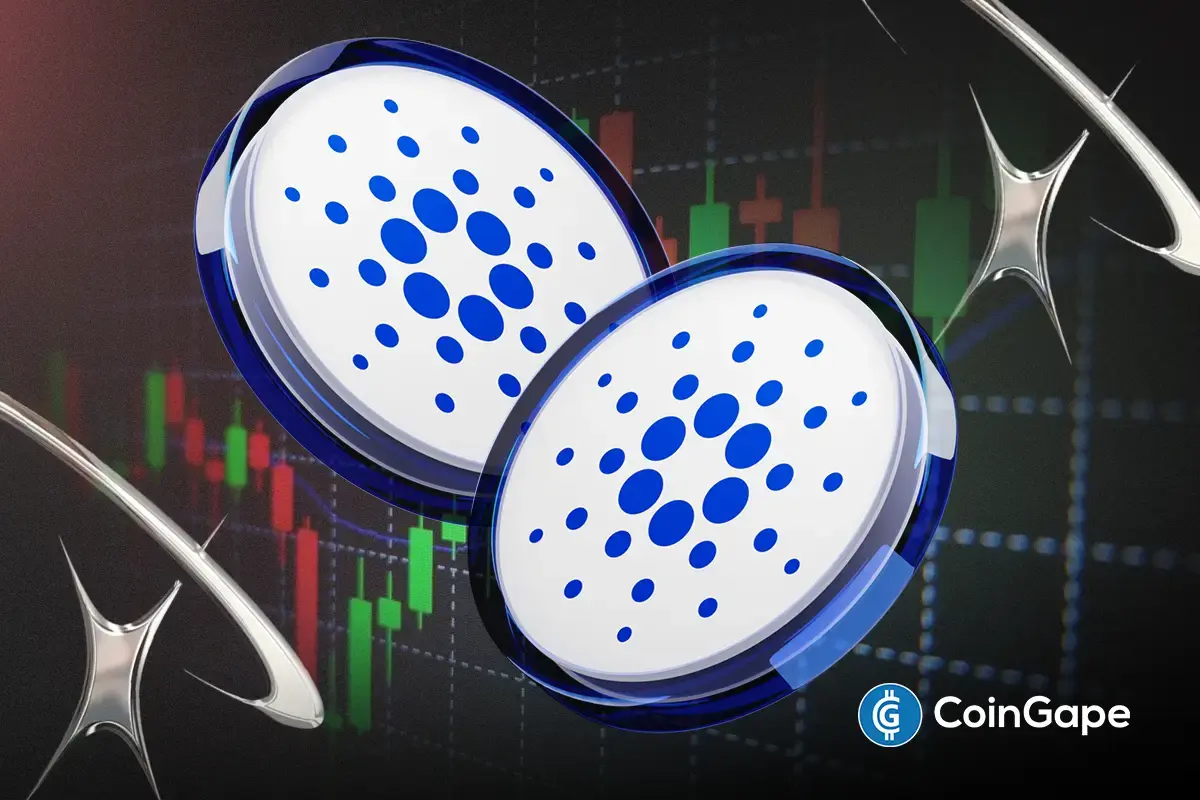
 Altcoin16 hours ago
Altcoin16 hours agoWill Cardano Price Bounce Back to $0.70 or Crash to $0.60?
-

 Market8 hours ago
Market8 hours agoXRP Price Under Pressure—New Lows Signal More Trouble Ahead
-

 Altcoin8 hours ago
Altcoin8 hours agoAnalyst Forecasts 250% Dogecoin Price Rally If This Level Holds
























